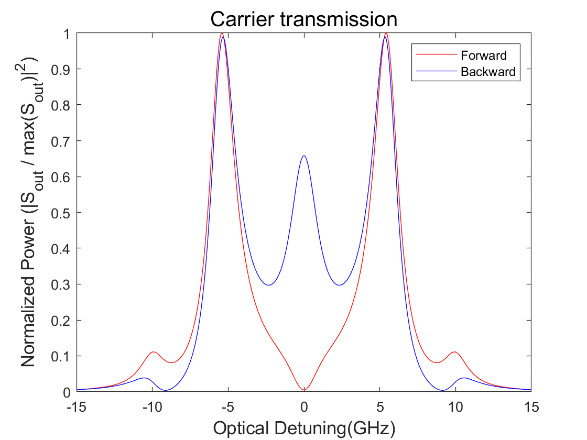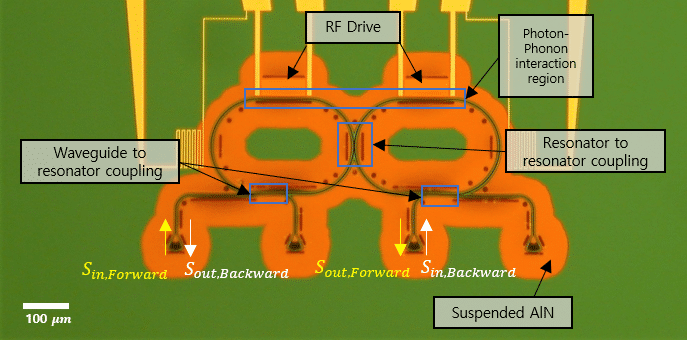
Optomechanical T-Symmetry Breaking in a Nanophotonic Resonator Chain
We demonstrate non-reciprocal transmission in a short coupled-resonator optical waveguide using piezoelectric optomechanics. Time-reversal symmetry for the light propagation through the system is broken by means of resonance frequency modulation with different phases on each resonator.
The reciprocity property for passive optical devices originates from the time-reversal symmetry of Maxwell’s equations. This symmetry must be broken to produce non-reciprocal responses [1] which are required for optical isolators or circulators. Here, we propose an integrated non-reciprocal photonic system consisting of two coupled ring resonators with time-varying resonance frequencies, each modulated with a different relative phase. We examine the case where the modulation frequency is comparable to the frequency separation between the individual resonator frequencies, and where the relative phase is set to 0.5π. As shown in Fig.1a, the equations of motion for the system predict that when sufficiently large modulation depth is applied, a significant non-reciprocal optical response is achieved at the average frequency between the two resonators. We experimentally test this prediction in an acoustically-modulated aluminum nitride integrated photonic system.
The device is fabricated as a pair of membrane-suspended racetrack resonators with frequency separation of 4.7 GHz induced by coupling between resonators. Aluminum nitride is used as the membrane material due to its relatively large piezoelectric coefficient and high optical transparency. The frequency of each resonator is modulated acoustically using two identical interdigitated transducers (IDT) having center frequency of 4.4 GHz, which are designed to match the eigenfrequency separation between the two coupled resonators. Acoustic reflectors (a free edge condition in the aluminum nitride layer) are fabricated so that standing acoustic waves are formed by the IDTs transverse to the propagation direction of the optical racetrack. We introduce a relative phase difference between the two resonance frequency modulations using an RF phase shifter prior to each IDT. Fig.1b shows a micrograph of the acoustically modulated nonreciprocal device.
|
a. |
b. |
|
Fig.1 (a) Predicted transmission function for the described nonreciprocal system. Calculation is based on ideal case where the identical resonators are critically coupled and modulation frequency is equal to the eigenfrequency spacing (ωm=Δω). (b) True-color micrograph of the aluminum nitride acoustically-modulated nonreciprocal device. |
|
References
[1] H. B. G. Casimir, Proceedings of the IEEE 51, 1570 (1963)
[2] D. B. Sohn, S. Kim and G. Bahl, “Time-reversal symmetry breaking with acoustic pumping of nanophotonic circuits” Nature Photonics 12, 91-97 (2018)

Powered by Eventact EMS

